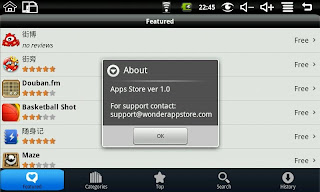Recently, I got an
Eken M002 Android tablet. Or rather, I think it's a M002, since neither the device nor the manual contains any sort of brand or make markings except "MID".
It has a 7" screen, built-in webcam, microphone, speakers, tilt sensor and WiFi. There's hard buttons for power on, menu, volume + and volume -, and an iPad-like back button. On the bottom, MicroSD slot, 3.5mm headphone jack, a power jack for the included power adapter and a custom slot that fits a weird little expansion box with an ethernet port and two USB ports.
OS-wise, it runs Android 1.6, kernel version 2.6.29, build number 1.7.3. Reported memory size is 256 MB, and the model number is reported as "generic". It's got 1GB internal storage, called LocalDisk.
It has the default Android Alarm Clock, Browser, Calendar, Camera, Contacts, Email, Gallery and Maps apps. The device doesn't have any location sources, so that last one is of limited use.
 |
| Magic Album |
In addition, there's a bunch of custom apps made by
WonderMedia Technologies, including Magic Album, My Music, My Photo and My Video, plus a number of utilities: File Browser, PK Manager (manages packages), Picture Capture (takes screenshots) and YouTube, the latter definitely not the official YouTube app.
Magic Album is actually pretty nice. Displays the weather (defaulting to Beijing), time and date. And since it prevents the device from sleeping, it actually is useful as a calendar/clock.
Finally it has Apps Store, which is the
Wonder App Store app. Looks nice, but a lot of the apps are Chinese, and I can't read Chinese.
 |
| Apps Store |
Finally, it has a bunch of shortcut apps. "Gravity sensor setting" links to exactly that, "Ethernet" links to the system settings Configure ethernet page, "Settings" links directly to the overall system settings list, "Wi-Fi settings" links directly to that.
The device feels noticeably slow opening apps and the touch screen isn't of the highest quality, needing a delicate touch to prevent the first touch of a scroll swipe from being read as a press. Web browsing works acceptably. I mostly use it as a clock and weather station with Magic Album and occasionally as a digital photo frame and for that, it works very well.
And with the not too-recent version of Android and the hdpi screen, it's a very,
very good platform for testing my apps on.


